child restraint CHEVROLET SILVERADO 2011 2.G Owner's Manual
[x] Cancel search | Manufacturer: CHEVROLET, Model Year: 2011, Model line: SILVERADO, Model: CHEVROLET SILVERADO 2011 2.GPages: 588, PDF Size: 7.99 MB
Page 124 of 588
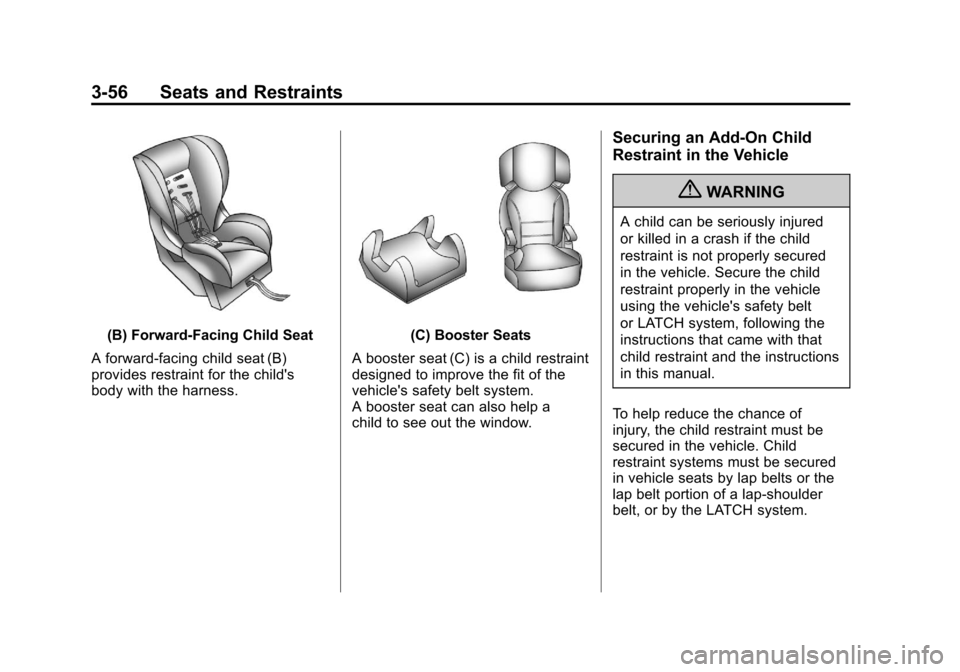
Black plate (56,1)Chevrolet Silverado Owner Manual - 2011
3-56 Seats and Restraints
(B) Forward-Facing Child Seat
A forward-facing child seat (B)
provides restraint for the child's
body with the harness.(C) Booster Seats
A booster seat (C) is a child restraint
designed to improve the fit of the
vehicle's safety belt system.
A booster seat can also help a
child to see out the window.
Securing an Add-On Child
Restraint in the Vehicle
{WARNING
A child can be seriously injured
or killed in a crash if the child
restraint is not properly secured
in the vehicle. Secure the child
restraint properly in the vehicle
using the vehicle's safety belt
or LATCH system, following the
instructions that came with that
child restraint and the instructions
in this manual.
To help reduce the chance of
injury, the child restraint must be
secured in the vehicle. Child
restraint systems must be secured
in vehicle seats by lap belts or the
lap belt portion of a lap-shoulder
belt, or by the LATCH system.
Page 125 of 588
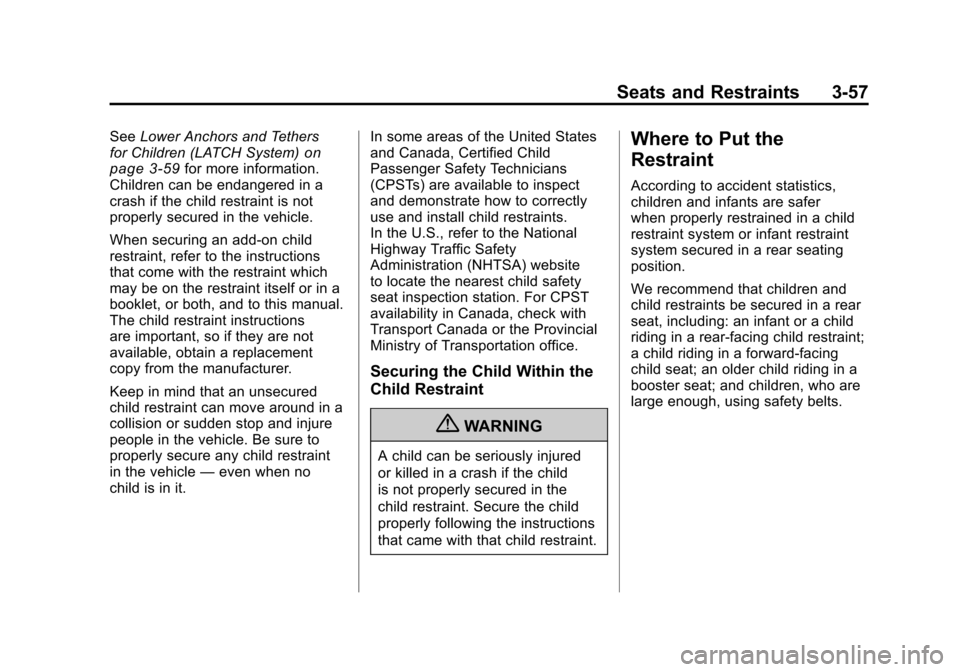
Black plate (57,1)Chevrolet Silverado Owner Manual - 2011
Seats and Restraints 3-57
SeeLower Anchors and Tethers
for Children (LATCH System)on
page 3‑59for more information.
Children can be endangered in a
crash if the child restraint is not
properly secured in the vehicle.
When securing an add-on child
restraint, refer to the instructions
that come with the restraint which
may be on the restraint itself or in a
booklet, or both, and to this manual.
The child restraint instructions
are important, so if they are not
available, obtain a replacement
copy from the manufacturer.
Keep in mind that an unsecured
child restraint can move around in a
collision or sudden stop and injure
people in the vehicle. Be sure to
properly secure any child restraint
in the vehicle —even when no
child is in it. In some areas of the United States
and Canada, Certified Child
Passenger Safety Technicians
(CPSTs) are available to inspect
and demonstrate how to correctly
use and install child restraints.
In the U.S., refer to the National
Highway Traffic Safety
Administration (NHTSA) website
to locate the nearest child safety
seat inspection station. For CPST
availability in Canada, check with
Transport Canada or the Provincial
Ministry of Transportation office.
Securing the Child Within the
Child Restraint
{WARNING
A child can be seriously injured
or killed in a crash if the child
is not properly secured in the
child restraint. Secure the child
properly following the instructions
that came with that child restraint.
Where to Put the
Restraint
According to accident statistics,
children and infants are safer
when properly restrained in a child
restraint system or infant restraint
system secured in a rear seating
position.
We recommend that children and
child restraints be secured in a rear
seat, including: an infant or a child
riding in a rear-facing child restraint;
a child riding in a forward-facing
child seat; an older child riding in a
booster seat; and children, who are
large enough, using safety belts.
Page 126 of 588
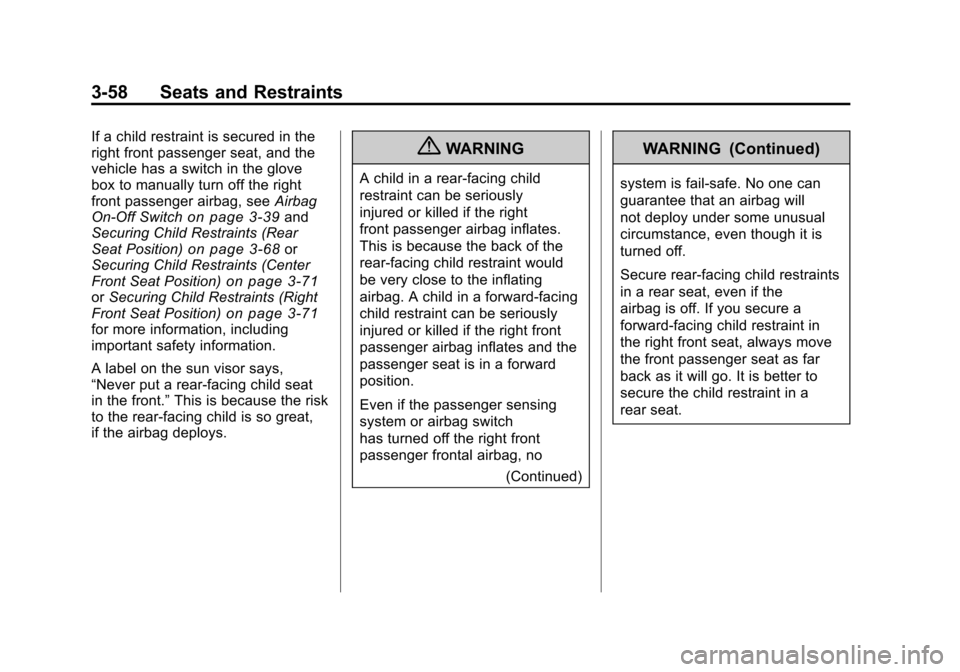
Black plate (58,1)Chevrolet Silverado Owner Manual - 2011
3-58 Seats and Restraints
If a child restraint is secured in the
right front passenger seat, and the
vehicle has a switch in the glove
box to manually turn off the right
front passenger airbag, seeAirbag
On-Off Switch
on page 3‑39and
Securing Child Restraints (Rear
Seat Position)
on page 3‑68or
Securing Child Restraints (Center
Front Seat Position)
on page 3‑71or Securing Child Restraints (Right
Front Seat Position)on page 3‑71for more information, including
important safety information.
A label on the sun visor says,
“Never put a rear-facing child seat
in the front.” This is because the risk
to the rear-facing child is so great,
if the airbag deploys.
{WARNING
A child in a rear-facing child
restraint can be seriously
injured or killed if the right
front passenger airbag inflates.
This is because the back of the
rear-facing child restraint would
be very close to the inflating
airbag. A child in a forward-facing
child restraint can be seriously
injured or killed if the right front
passenger airbag inflates and the
passenger seat is in a forward
position.
Even if the passenger sensing
system or airbag switch
has turned off the right front
passenger frontal airbag, no
(Continued)
WARNING (Continued)
system is fail-safe. No one can
guarantee that an airbag will
not deploy under some unusual
circumstance, even though it is
turned off.
Secure rear-facing child restraints
in a rear seat, even if the
airbag is off. If you secure a
forward-facing child restraint in
the right front seat, always move
the front passenger seat as far
back as it will go. It is better to
secure the child restraint in a
rear seat.
Page 127 of 588
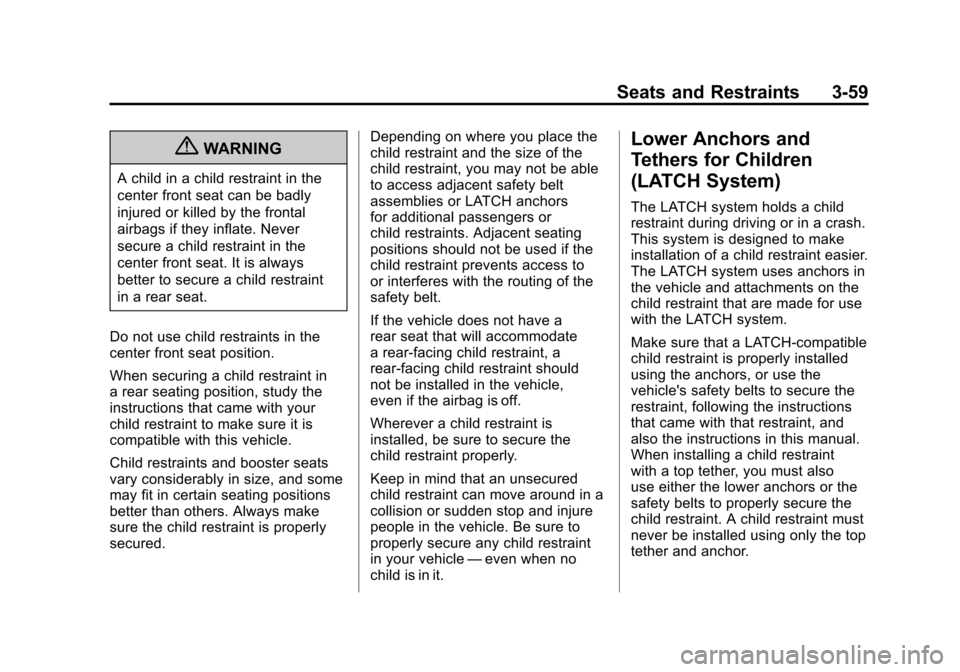
Black plate (59,1)Chevrolet Silverado Owner Manual - 2011
Seats and Restraints 3-59
{WARNING
A child in a child restraint in the
center front seat can be badly
injured or killed by the frontal
airbags if they inflate. Never
secure a child restraint in the
center front seat. It is always
better to secure a child restraint
in a rear seat.
Do not use child restraints in the
center front seat position.
When securing a child restraint in
a rear seating position, study the
instructions that came with your
child restraint to make sure it is
compatible with this vehicle.
Child restraints and booster seats
vary considerably in size, and some
may fit in certain seating positions
better than others. Always make
sure the child restraint is properly
secured. Depending on where you place the
child restraint and the size of the
child restraint, you may not be able
to access adjacent safety belt
assemblies or LATCH anchors
for additional passengers or
child restraints. Adjacent seating
positions should not be used if the
child restraint prevents access to
or interferes with the routing of the
safety belt.
If the vehicle does not have a
rear seat that will accommodate
a rear-facing child restraint, a
rear-facing child restraint should
not be installed in the vehicle,
even if the airbag is off.
Wherever a child restraint is
installed, be sure to secure the
child restraint properly.
Keep in mind that an unsecured
child restraint can move around in a
collision or sudden stop and injure
people in the vehicle. Be sure to
properly secure any child restraint
in your vehicle
—even when no
child is in it.
Lower Anchors and
Tethers for Children
(LATCH System)
The LATCH system holds a child
restraint during driving or in a crash.
This system is designed to make
installation of a child restraint easier.
The LATCH system uses anchors in
the vehicle and attachments on the
child restraint that are made for use
with the LATCH system.
Make sure that a LATCH-compatible
child restraint is properly installed
using the anchors, or use the
vehicle's safety belts to secure the
restraint, following the instructions
that came with that restraint, and
also the instructions in this manual.
When installing a child restraint
with a top tether, you must also
use either the lower anchors or the
safety belts to properly secure the
child restraint. A child restraint must
never be installed using only the top
tether and anchor.
Page 128 of 588
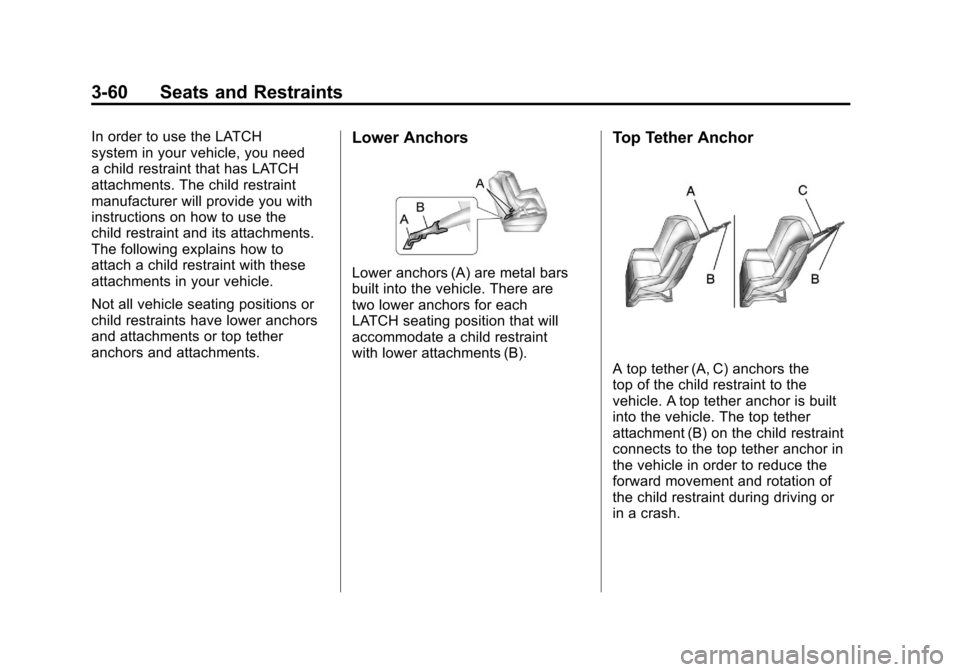
Black plate (60,1)Chevrolet Silverado Owner Manual - 2011
3-60 Seats and Restraints
In order to use the LATCH
system in your vehicle, you need
a child restraint that has LATCH
attachments. The child restraint
manufacturer will provide you with
instructions on how to use the
child restraint and its attachments.
The following explains how to
attach a child restraint with these
attachments in your vehicle.
Not all vehicle seating positions or
child restraints have lower anchors
and attachments or top tether
anchors and attachments.Lower Anchors
Lower anchors (A) are metal bars
built into the vehicle. There are
two lower anchors for each
LATCH seating position that will
accommodate a child restraint
with lower attachments (B).
Top Tether Anchor
A top tether (A, C) anchors the
top of the child restraint to the
vehicle. A top tether anchor is built
into the vehicle. The top tether
attachment (B) on the child restraint
connects to the top tether anchor in
the vehicle in order to reduce the
forward movement and rotation of
the child restraint during driving or
in a crash.
Page 129 of 588
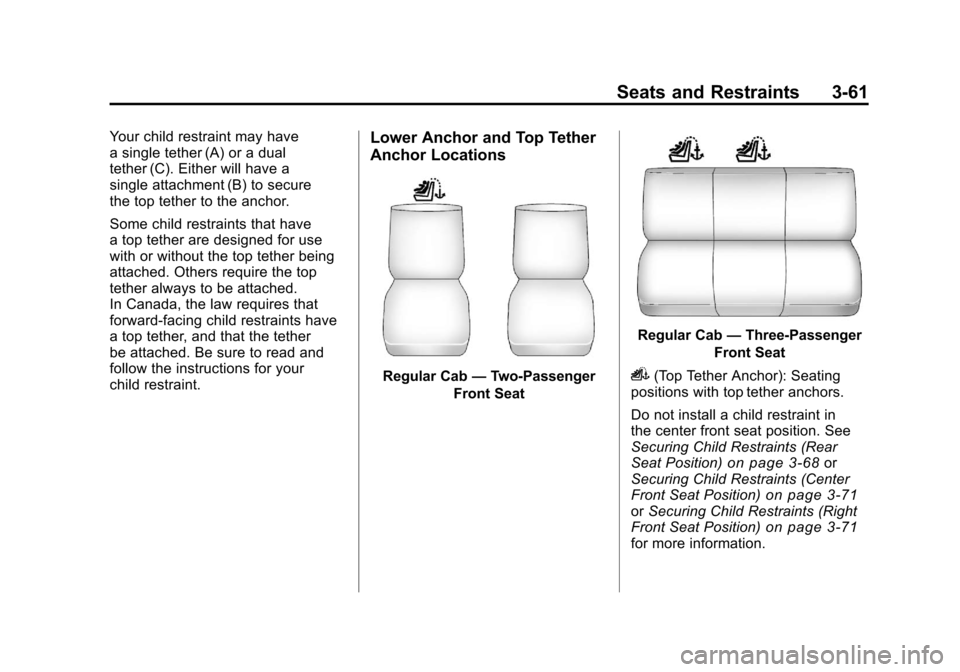
Black plate (61,1)Chevrolet Silverado Owner Manual - 2011
Seats and Restraints 3-61
Your child restraint may have
a single tether (A) or a dual
tether (C). Either will have a
single attachment (B) to secure
the top tether to the anchor.
Some child restraints that have
a top tether are designed for use
with or without the top tether being
attached. Others require the top
tether always to be attached.
In Canada, the law requires that
forward-facing child restraints have
a top tether, and that the tether
be attached. Be sure to read and
follow the instructions for your
child restraint.Lower Anchor and Top Tether
Anchor Locations
Regular Cab—Two-Passenger
Front Seat
Regular Cab —Three-Passenger
Front Seat
i(Top Tether Anchor): Seating
positions with top tether anchors.
Do not install a child restraint in
the center front seat position. See
Securing Child Restraints (Rear
Seat Position)
on page 3‑68or
Securing Child Restraints (Center
Front Seat Position)
on page 3‑71or Securing Child Restraints (Right
Front Seat Position)on page 3‑71for more information.
Page 130 of 588
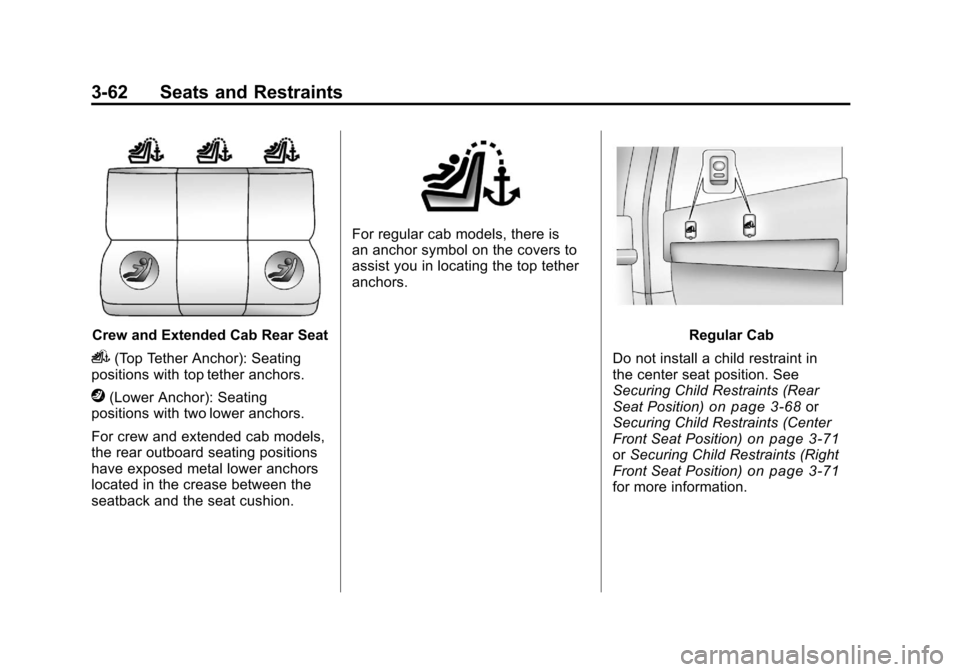
Black plate (62,1)Chevrolet Silverado Owner Manual - 2011
3-62 Seats and Restraints
Crew and Extended Cab Rear Seat
i(Top Tether Anchor): Seating
positions with top tether anchors.
j(Lower Anchor): Seating
positions with two lower anchors.
For crew and extended cab models,
the rear outboard seating positions
have exposed metal lower anchors
located in the crease between the
seatback and the seat cushion.
For regular cab models, there is
an anchor symbol on the covers to
assist you in locating the top tether
anchors.
Regular Cab
Do not install a child restraint in
the center seat position. See
Securing Child Restraints (Rear
Seat Position)
on page 3‑68or
Securing Child Restraints (Center
Front Seat Position)
on page 3‑71or Securing Child Restraints (Right
Front Seat Position)on page 3‑71for more information.
Page 131 of 588
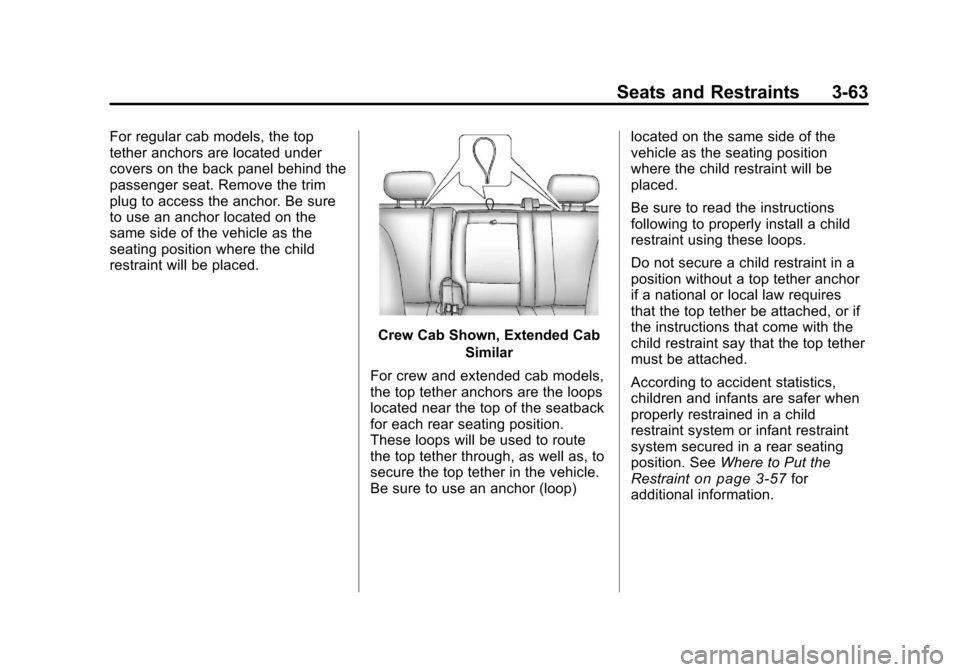
Black plate (63,1)Chevrolet Silverado Owner Manual - 2011
Seats and Restraints 3-63
For regular cab models, the top
tether anchors are located under
covers on the back panel behind the
passenger seat. Remove the trim
plug to access the anchor. Be sure
to use an anchor located on the
same side of the vehicle as the
seating position where the child
restraint will be placed.
Crew Cab Shown, Extended CabSimilar
For crew and extended cab models,
the top tether anchors are the loops
located near the top of the seatback
for each rear seating position.
These loops will be used to route
the top tether through, as well as, to
secure the top tether in the vehicle.
Be sure to use an anchor (loop) located on the same side of the
vehicle as the seating position
where the child restraint will be
placed.
Be sure to read the instructions
following to properly install a child
restraint using these loops.
Do not secure a child restraint in a
position without a top tether anchor
if a national or local law requires
that the top tether be attached, or if
the instructions that come with the
child restraint say that the top tether
must be attached.
According to accident statistics,
children and infants are safer when
properly restrained in a child
restraint system or infant restraint
system secured in a rear seating
position. See
Where to Put the
Restraint
on page 3‑57for
additional information.
Page 132 of 588
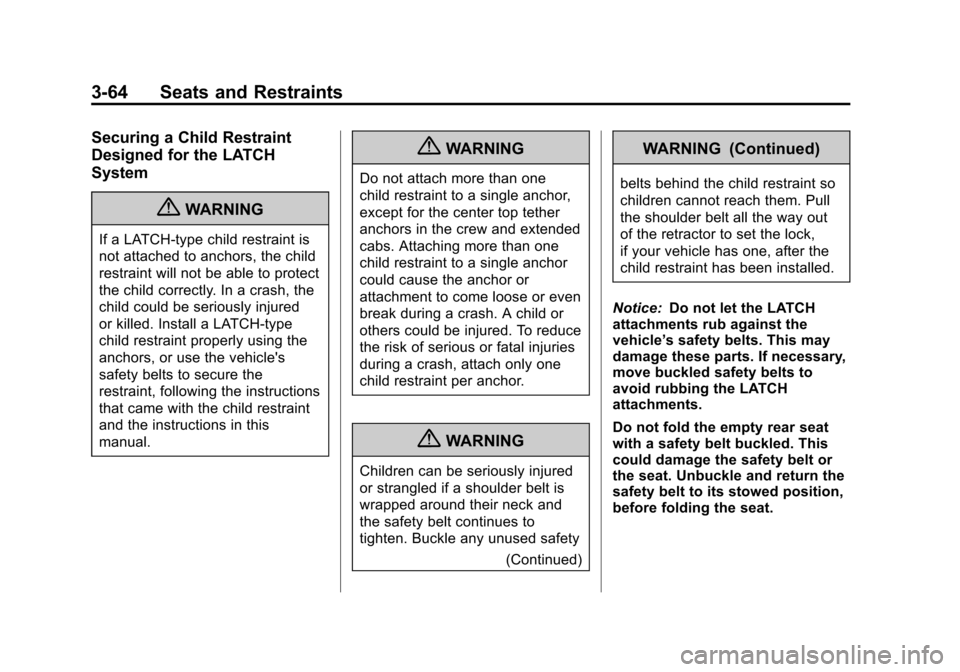
Black plate (64,1)Chevrolet Silverado Owner Manual - 2011
3-64 Seats and Restraints
Securing a Child Restraint
Designed for the LATCH
System
{WARNING
If a LATCH-type child restraint is
not attached to anchors, the child
restraint will not be able to protect
the child correctly. In a crash, the
child could be seriously injured
or killed. Install a LATCH-type
child restraint properly using the
anchors, or use the vehicle's
safety belts to secure the
restraint, following the instructions
that came with the child restraint
and the instructions in this
manual.
{WARNING
Do not attach more than one
child restraint to a single anchor,
except for the center top tether
anchors in the crew and extended
cabs. Attaching more than one
child restraint to a single anchor
could cause the anchor or
attachment to come loose or even
break during a crash. A child or
others could be injured. To reduce
the risk of serious or fatal injuries
during a crash, attach only one
child restraint per anchor.
{WARNING
Children can be seriously injured
or strangled if a shoulder belt is
wrapped around their neck and
the safety belt continues to
tighten. Buckle any unused safety(Continued)
WARNING (Continued)
belts behind the child restraint so
children cannot reach them. Pull
the shoulder belt all the way out
of the retractor to set the lock,
if your vehicle has one, after the
child restraint has been installed.
Notice: Do not let the LATCH
attachments rub against the
vehicle’ s safety belts. This may
damage these parts. If necessary,
move buckled safety belts to
avoid rubbing the LATCH
attachments.
Do not fold the empty rear seat
with a safety belt buckled. This
could damage the safety belt or
the seat. Unbuckle and return the
safety belt to its stowed position,
before folding the seat.
Page 133 of 588
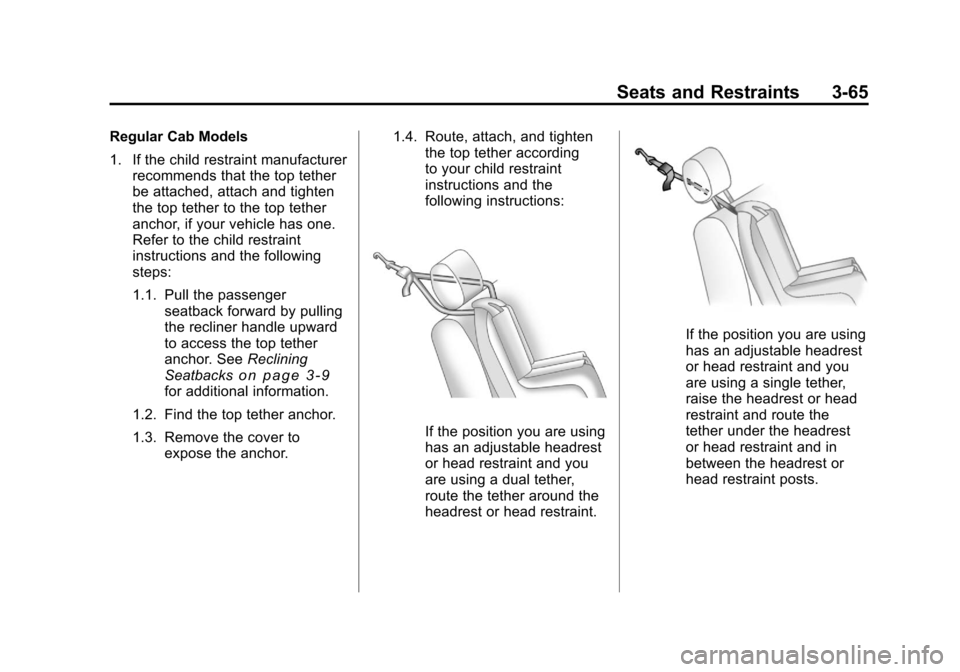
Black plate (65,1)Chevrolet Silverado Owner Manual - 2011
Seats and Restraints 3-65
Regular Cab Models
1. If the child restraint manufacturerrecommends that the top tether
be attached, attach and tighten
the top tether to the top tether
anchor, if your vehicle has one.
Refer to the child restraint
instructions and the following
steps:
1.1. Pull the passenger seatback forward by pulling
the recliner handle upward
to access the top tether
anchor. See Reclining
Seatbacks
on page 3‑9for additional information.
1.2. Find the top tether anchor.
1.3. Remove the cover to expose the anchor. 1.4. Route, attach, and tighten
the top tether according
to your child restraint
instructions and the
following instructions:
If the position you are using
has an adjustable headrest
or head restraint and you
are using a dual tether,
route the tether around the
headrest or head restraint.
If the position you are using
has an adjustable headrest
or head restraint and you
are using a single tether,
raise the headrest or head
restraint and route the
tether under the headrest
or head restraint and in
between the headrest or
head restraint posts.